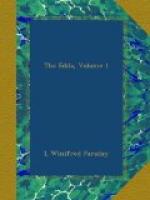Notes
Home of the Edda. (Page 2.)
The chief apologists for the British theory are Professor Bugge (Studien ueber die Entstehung der nordischen Goetter- und Heldensagen, Muenchen, 1889), and the editors of the Corpus Poeticum Boreale (see the Introduction to that work, and also the Prolegomena prefixed to their edition of the Sturlunga Saga, Oxford). The case for Norway and Greenland is argued by Dr. Finnur Jonsson (Den oldnorsk og oldislandske Literaturs-Historie, Copenhagen). The cases for both British and Norwegian origin are based chiefly on rather fanciful arguments from supposed local colour. The theory of the Corpus Poeticum editors that many of the poems were composed in the Scottish isles is discredited by the absence of Gaelic words or traces of Gaelic legend. Professor Bugge’s North of England theory is slightly stronger, being supported by several Old English expressions in the poems, but these are not enough to prove that they were composed in England, since most Icelanders travelled east at some time of their lives.
(Page 3.)
A later study will deal with the Heroic legends.
Ynglinga Saga. (Page 3.)
Ynglinga Saga is prefixed to the Lives of the Kings in the collection known as Heimskringla (edited by Unger, Christiania, 1868, and by Finnur Jonsson, Christiania, 1893); there is an English translation in Laing’s Lives of the Kings of Norway (London, 1889).
Voeluspa. (Page 4.)
A poem of similar form occurs among the heroic poems. Gripisspa, a prophetic outline of Sigurd’s life, introduces the Volsung poems, as Voeluspa does the Asgard cycle.
Riddle-poems. (Page 6.)
So many of the mythological poems are in this form that they suggest the question, did the asking of riddles form any part of Scandinavian ritual?
The Aesir. (Page 11.)
Ynglinga Saga says that Odin and the Aesir came to Norway from Asia; a statement due, of course, to a false etymology, though theories as to the origin of Norse mythology have been based on it.
Tyr. (Page 12.)
Tyr is etymologically identical with Zeus, and with
the Sanskrit Dyaus
(Sky-God).
Baldr. (Pages 16 to 22.)
The Baldr theories are stated in the following authorities:
(1) Ritual origin: Frazer, The Golden Bough, vol. 3.
(2) Heroic origin: Golther, Handbuch der Germanischen Mythologie (Leipzig, 1895); Niedner, Eddische Fragen (Zeitschrift fuer deutsches Altertum, new series, 29), Zur Lieder-Edda (Zeitschr. f. d. Alt. vol. 36).
(3) Solar myth: Sir G.W. Cox, Mythology of the Aryan Nations (London, 1870); Max Mueller, Chips from a German Workshop, vol. 4.




